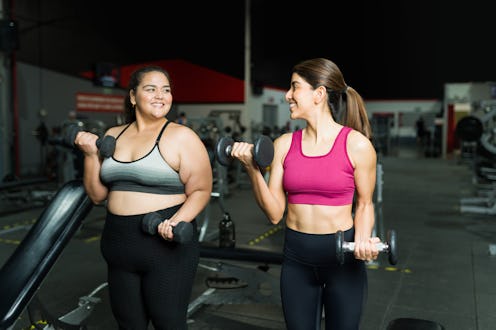Fitness
Trainers Reveal How Long You Should Rest Between Sets
It's longer than you might think.

Whether you’re trying to test your muscle stamina or rush through your workout so you can leave the gym, doing 50 bicep curls in a row isn’t going to do your body any favors. The same is true for squats, deadlifts, or any other strength training move. If you want to make the most of each exercise, it’s important to rest between each set — and to rest for the correct amount of time.
Most strength training workouts are broken down into little chunks called reps (repetitions) and sets, explains Ariel Hendricks, a certified personal trainer and owner of Fitness Rx. “Sets are a group of reps,” she explains. “These are suggested according to the specific outcome you’re looking for while training. For instance, if you’re interested in gaining strength you could do three sets of 10 to 12 reps of an exercise.”
An ideal workout would include the prescribed amount of reps and sets for each exercise or group of exercises you plan on doing that day, plus the rest time in between, says Tessa Breeden, an ACE-certified personal trainer and fitness nutrition specialist. “People tend to move through their workouts quickly if they have too many exercises programmed, are trying to just get through a workout, or are not resting for long enough between their sets,” she tells Bustle. But slowing down has its perks.
To ensure you take enough breaks — and to make the most of all those squats, lifts, and curls — read on below for how long to rest between sets, according to trainers.
How Long To Rest Between Sets
How long you rest between sets depends on your personal goals as well as the type of exercise you plan to do. Are you doing deadlifts to build strength and power? Or are you doing hamstring curls to sculpt your legs? While they may sound like the same thing, Breeden says gaining strength and growing muscle are slightly different.
“Gaining strength and growing muscle are definitely complementary, but by gaining strength, you're not necessarily growing muscle,” she says. Think of gaining strength as building power so you can lift heavy things, while growing muscle is all about working out, resting, and eating more protein so your glutes get perkier. And the amount of time you rest between sets depends on which one you’re going for.
To Build Strength, Rest For 3-5 Minutes
If your goal is to increase your strength, performance, and power — or if you’re doing a more intense workout with heavier weights — aim to rest for three to five minutes between each set, says Rob Wagener, an ACE-certified personal trainer and nutrition coach. This will allow your muscles enough time to recover without decreasing your heart rate too much.
Doing tough compound strength movements like deadlifts, bench presses, overhead presses, and pull-ups will also work best with three to five minutes of recovery between sets, says Breedan. “After the rest period, your muscles have essentially refilled with fuel and are able to endure additional muscle tension — more weight load, increased time under tension, or additional reps,” she says.
To Build Muscle, Rest For 30-90 Seconds
If your goal is to build muscle and/or sculpt, then you really only need to rest for 30 to 90 seconds between sets. “This is recommended for exercises like bicep curls, hamstring curls, leg extensions, lateral raises, or chest flys,” Breeden says. “This rest time is favorable in maximizing hypertrophy,” aka muscle growth.
These single-joint movements also don’t require much of a break, especially if you’re using a lighter weight. But that doesn’t mean they aren’t important for your overall strength routine. As Breeden says, “They can help with muscle imbalances, aid in rehab after an injury, and help to build up muscles necessary for compound exercises.”
What To Do While You Rest
When resting between sets, you can grab a quick drink or shake out your arms or legs. “While you’re resting, the goal is to keep blood flowing to the muscle group you’re working, and then continue reps while your heart rate is still elevated,” Hendricks explains. Finish your set, shake it out, sip some water, then get back to it.
It’s also recommended to stay by your weights and think about your next move instead of, say, pacing around or shuffling through your music. “Stay focused on your task and try not to let your mind wander too far,” Hendricks adds, otherwise you might be too distracted to do your next round with good form.
What Happens If You Don’t Rest Between Sets
Taking a break between sets is important so you can maintain good form, which is a key element in any fitness routine. You want to go into your next set knowing you can curl that dumbbell or lift that barbell the correct way, Hendricks says, or else you run the risk of pulling a muscle or getting injured.
Skipping your rest period can also make you extra sore the following day due to the accumulation of lactic acid in your muscles that happens when you go too hard, Breeden says. By resting between sets, you give your muscles a little breather and it ensures you’re ready to strength train with intention.
Studies referenced:
Cheung, K. (2003). Delayed onset muscle soreness : treatment strategies and performance factors. Sports Med. doi: 10.2165/00007256-200333020-00005.
de Freitas, MC. (2017). Role of metabolic stress for enhancing muscle adaptations: Practical applications. World J Methodol. doi: 10.5662/wjm.v7.i2.46.
de Salles, BF. (2009). Rest interval between sets in strength training. Sports Med. doi: 10.2165/11315230-000000000-00000.
Krzysztofik, M. (2019). Maximizing Muscle Hypertrophy: A Systematic Review of Advanced Resistance Training Techniques and Methods. Int J Environ Res Public Health. doi: 10.3390/ijerph16244897.
Sources:
Ariel Hendricks, certified personal trainer, owner of Fitness Rx
Tessa Breeden, ACE-certified personal trainer, fitness nutrition specialist
Rob Wagener, a NASM-certified personal trainer and nutrition coach
This article was originally published on